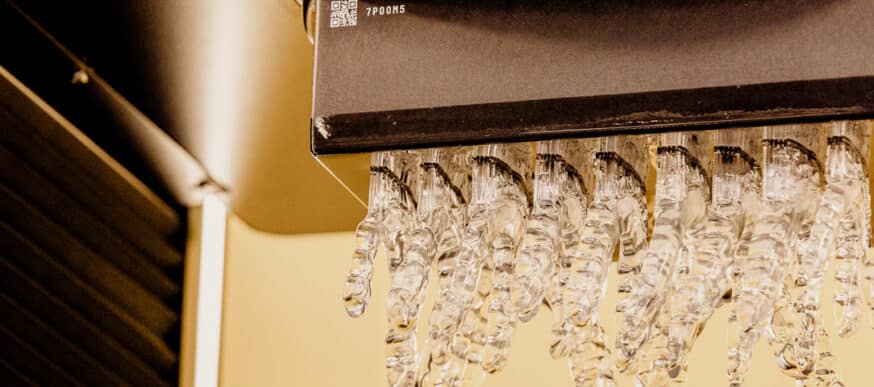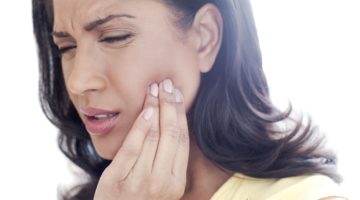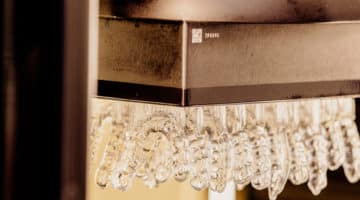TMJ dental appliances are occlusal guards used for treating TMD and TMJ (temporomandibular joint) pain. They consist of a single custom-fitted tray, or a dual arch design. The goal of these devices is to support the TMJ and in some cases retrain muscles to avoid harmful movements.
These devices are custom-made for each patient, and are sold by prescription only. The dentist is expected to evaluate the patient and assess which treatment path is most appropriate. If the TMJ treatment includes an intraoral appliance, the dentist will determine which one is best suited for the individual case.
Types of intraoral devices for TMJ dental treatment
Anterior Deprogrammer
The anterior deprogrammer is a device that covers the entire arch and discludes the posteriors via an anterior ramp to retrain jaw muscles and prevent bruxing. The device is primarily used on the upper arch. It better protects teeth due to coverage of the full arch as well as greater retention than an NTI given its full coverage. There may be some occlusion which will interfere with retraining the jaw muscles.
Pros
Better protects teeth due to full arch coverage
Provides greater retention than the NTI given the full arch coverage.
Con
Due to the coverage on the posteriors, there may be some occlusion which will interfere with retraining the jaw muscles.
NTI Device
The NTI device is a small unobtrusive device on the anteriors that avoids occlusion of the posterior teeth to inhibit bruxism and relieve stress. It is important to note that the NTI device only covers only teeth #7 – #10 on the upper arch.
Pro
Completely prevents occlusion so it retrains patient’s muscles to not brux at all.
Con
Given the small size, some patients may struggle with retention
Dawson B-Splint
A device that covers both arches and avoids occlusion of the posteriors to inhibit bruxism and relieve stress while allowing horizontal movement.
Pros
Provides coverage of both the upper and lower arches, providing complete protection.
Facilitates and supports lateral and excursive movements.
Con
Does not retrain patients’ muscles to actually prevent the root cause.
Gelb Appliance
The Gelb Appliance sits on the posteriors and repositions to the mandible to control the positioning of the jaw and avoid excess force. In addition to controlling the positioning of the jaw, it also maintains the mandible arch shape. It also brings the condyle into a more anterior, resulting in an inferior position in the fossa and increases the vertical opening, which can relieve pain.
Pros
Provides complete protection for the posteriors
Allows for more tongue space by cutting away the anterior coverage which is beneficial for patients who snore, have sleep apnea, and/or have a large tongue
Con
Does not retrain patients’ muscles to actually prevent the root cause
Selecting the right TMJ dental appliance for your patient
The correct treatment often hinges on the root cause of the problem. In order to properly diagnose the patient, it is important to take proper imaging, either X-rays or CBCT scans. This, in addition to standard exam questions, is key to understand if the root cause of the issue is due to muscle spasms or damage in the joint (the joint can erode or move out of proper alignment, cartilage can be damaged, or the joint could be damaged from impact).
Here are ideal use cases by appliance:
Anterior Deprogrammer
The Anterior Deprogrammer works well for cases where you want full arch coverage and protection, but also to prevent occlusion. It is also good for treating TMD cases where the root cause is a muscle problem (but can treat all cases).
NTI
The NTI works well for cases where the goal is to prevent any form bruxism, rather than mitigate the impact or pain. It is very helpful for temporal headache patients and quite good for treating TMD cases where the root cause is a muscle problem.
Dawson B-Splint
The Dawson B-splint is a good fit for cases where it is important to provide full arch coverage and support excursive movements, rather than prevent them. It is good for long term use and protection for those with significant parafunction and also eliminates the possibility of posterior super eruption.
Gelb Appliance
The Gelb is a good fit for cases where it is important to provide support and relieve pain in the TMJ. It also works well for patients who struggle with airway obstruction given the anterior design.
Looking for a digital lab that makes TMJ appliances?
Dandy can help you relieve TMJ pain in your patients with the perfect balance of comfort and durability in our appliances. Explore Dandy’s appliances, splints, and guards.



